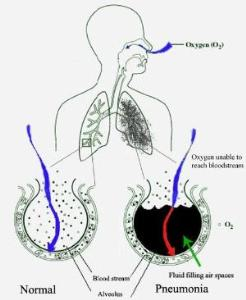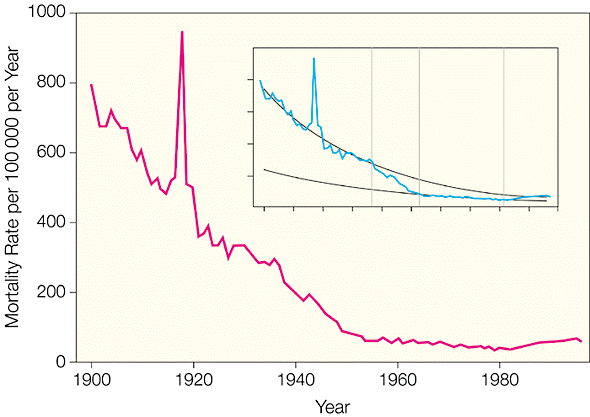Introduction
Pneumonia is infectivity habitually caused by fungi, bacteria or viruses and affects either one lung or both. Once it attacks a person, it causes swelling of the parenchyma-alveoli of the lung. Additionally, it causes fluid inflow to the alveolar sacs hence, exudation and consolidation of the respiratory system. Statistics reveal that before the invention of antibiotics, over 30 percent of infected people died of the infection. As of now, there are approximately three million people suffering from pneumonia in the United States alone. The prognosis of pneumonia relies on the nature of pneumonia, a person’s causal fitness, and the cure involved (Hoare &Wei, 2006, p. 1077).

How People Catch Pneumonia
In most cases, people catch pneumonia through breathing in some globules of contaminated air. Consequently, if a healthy person exposes to the contaminated air and inhales it, then infection occurs. On the other hand, the microorganisms usually present in the mouth, throat or nose can enter the lung(s) by mistake and lead to pneumonia infection. Research shows that when persons are slumbering, the mouth, nose and throat aspirate secretions.
Thus, due to reflex responses, healthy persons cannot catch pneumonia as their immune system thwarts any aspiration of microorganisms from entering the lung(s) hence, reducing the chances of developing pneumonia. However, persons suffering from other diseases can have a weak immune system that can allow aspiration of pneumonia into the lungs leading to severe pneumonia attack. The vast majority of people who are at great risk of catching pneumonia include those recently infected by a virus, lung or heart ailments, and individuals with swallowing difficulties. Others include alcohol consumers, drug users and persons who regularly experience stroke or seizure.
Older people are at high risk of catching pneumonia simply because of the weakened immune system and enhanced swallowing problems. Moreover, older persons have unimpressive medication side effects, which increase the chances of catching pneumonia. Catching pneumonia simply means organisms finding their way into the lung(s). Consequently, they inhabit the region around the air sacs and lung passages. Here, the organisms swiftly increase in number and causes the area to block up with inflammatory cells (pus). At this stage, the body will start fighting back the infection (Metlay, Kapoor & Fine, 1997, pp. 1440-1445).
Signs and Symptoms of Pneumonia
The signs and symptoms of pneumonia vary from one person to another. In most cases, pneumonia begins with upper respiratory infection characterized by sneezing, coughing and a sore throat. Later on, patients develop a very high fever, shuddering chills, and a severe cough normally accompanied by sputum. In order to differentiate pneumonia from similar infections, the sputum produced because of pneumonia invasion appears discolored and contains blood droplets. Additional symptoms can develop depending on where the organisms are affected most. For instance, if severe infection occurs at the air passages, then a person will experience persistent coughing and more sputum production.
On the other hand, if infection occurs on the spongy tissue within the lungs largely dominated by air sacs, massive oxygenation impairments results. Moreover, such instances can lead to lung stiffening where patients experience shortness of breath. Consequently, poorly oxygenated blood leads to changes in skin color where patients turn purplish or dusky; a condition medics term cyanosis. Just on the facade of the lungs exist pain fibers located in a region known as the pleura. This region is the one responsible for any pain a person may experience. For example, if the outer regions of the lung slum to this region, a person will feel chest pains.
Normally, the pain exacerbates when one takes a deep breath, a condition medical practitioners term pleurisy or pleuritic pain. Other symptoms include headache, pestering cough and aching muscles depending whether the causative organism is a fungi, a bacteria or a virus. For example, pneumonia resulting from Legionella invasion causes diarrhea and abdominal pain, while Pneumocystis leads to weight loss and sweating at night. Surprisingly, children infected by pneumonia organisms do not experience chest pains but exhibit symptoms like fever, constant illness, and lassitude. On the other hand, elderly persons experience delirium and instability that make them fall down easily (Hoare &Wei, 2006, pp. 1077-1079).
Diagnosis of Pneumonia
From the symptoms of pneumonia, medics can easily examine and diagnose suspected persons. For instance, they use a stethoscope to examine uncouth breathing or cracking sounds in a person before proceeding to perform a chest X-ray for confirmation. Additionally, medics use techniques such as sputum samples, blood test and bronchoscopy to diagnose patients.

Organisms Causing Pneumonia and their Treatment
Bacteria
These bacteria are the universal cause of pneumococcal disease causing fever, sputum production and shaking chills. To prevent the disease, medics recommend a pneumococcal conjugate vaccine for children aged four years and below and a pneumococcal polysaccharide vaccine for adults including diabetics and alcoholics. Antibiotics such as penicillin, amoxicillin, clarithromycin and erythromycin can treat the disease.
Virus
Viruses such as flu, respiratory syncytial virus, and adenoviruses cause a disease called viral pneumonia. These viruses weaken the body’s immune system hence, rendering it to pneumonia attack.
Fungi
Fungi infections such as histoplasmosis, aspergillosis and blastomycosis lead to pneumonia attacks. Nevertheless, unlike viral infections, which do not have antibiotics, amphotericin, penicillin and sulfonamides can treat fungal infections in reference to each fungus. The developments of antibiotics and successive therapies have enabled easier treatment of pneumonia in many hospitals. Perhaps this is the reason why there are a few deaths resulting from pneumonia (WHO, 1999, pp. 177-183).
Conclusion
The fact that people can catch pneumonia by breathing in contaminated air makes it one of the most dangerous diseases. The infections do not spare any age group as children, adults and even those already with medical complications can add it to their list. Nevertheless, with the development of numerous antibiotics preventing and treating different infections, humanity is not at high risk. In fact, people suffering from pneumonia can take oral antibiotics and heal with no hospitalization.
Reference List
Anevlavis, S. & Bouros, D. (2010). Community acquired bacterial pneumonia. Expert Opinion Pharmacotherapy, 11(3), 361–374.
Hoare, Z. &Wei L. (2006). Pneumonia: Update on Diagnosis and Management. British Medical Journal, 332, 1077-1079.
Metlay, J., Kapoor, W. & Fine. M. (1997). Does this patient have community-acquired pneumonia? Diagnosing pneumonia by history and physical examination. Journal of American Medical Association, 278(17), 1440-1445.
WHO. (1999). Pneumococcal vaccines. WHO position paper? Weekly Epidemiology Recordings, 74(23), 177-183.